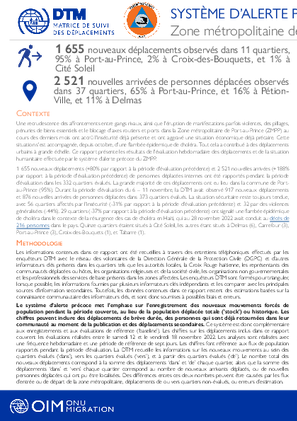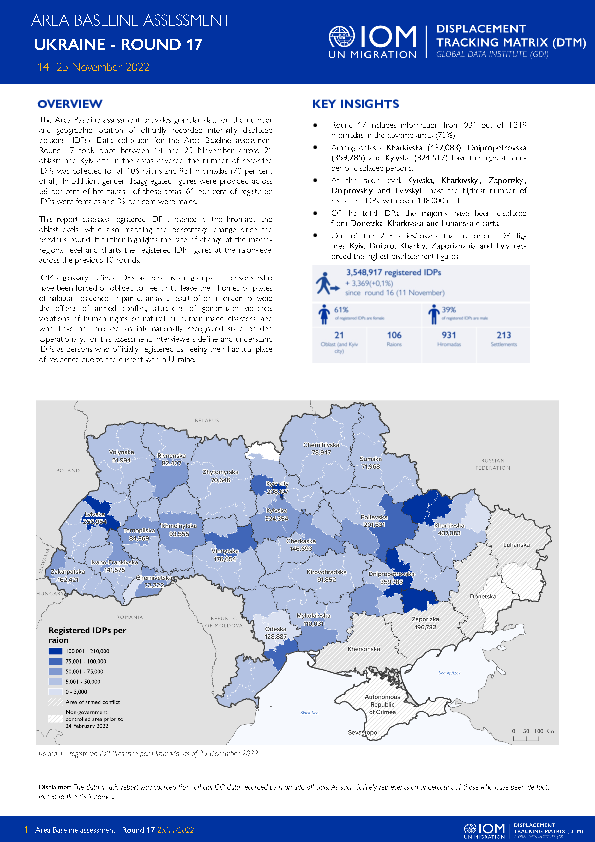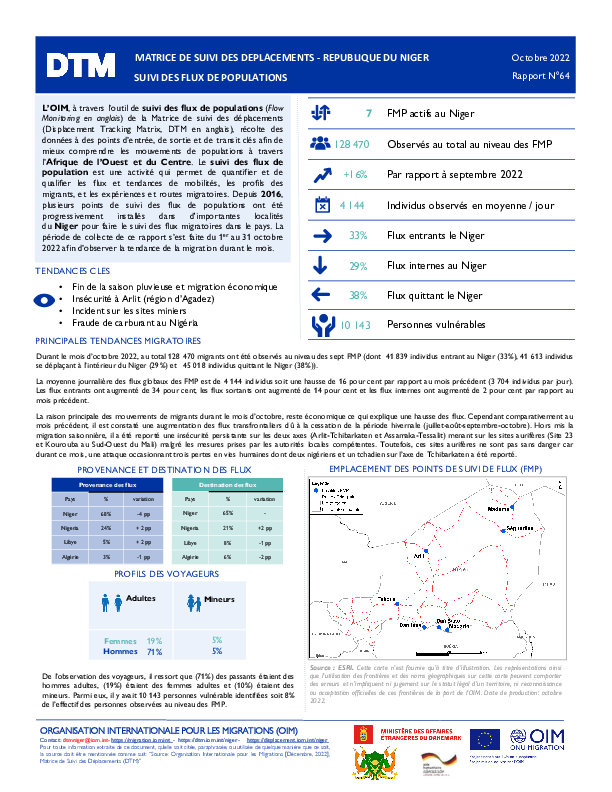-
Countries
-
Data and Analysis
-
Special Focus
-
Crisis Responses

Contact
DTM Yemen, iomyemendtm@iom.int
Language
Arabic
Location
Yemen
Period Covered
Nov 01 2022
Nov 30 2022
Activity
- Flow Monitoring
في نوفمبر 2022 ، سجلت مصفوفة تتبع النزوح (DTM) التابعة للمنظمة الدولية للهجرة في اليمن 9,212 مهاجرًا دخلوا اليمن ،بزيادة قدرها (%44) مقارنة بـ 6,381 مهاجرًا في اكتوبر 2022. سجلت مصفوفة تتبع النزوح في محافظة لحج زيادة في عدد الوافدين (31+%) مقارنة بالشهر الماضي كذلك شبوة هي الاخرى شهدت زيادةً هذا الشهر بحوالي (65+%). ويمكن ربط الزيادة العام بالأحوال الجوية والمد البحري وانحفاض دوريات خفر السواحل في جيبوتي. في حين أن الهحرة كانت في المقام الأول لأسباب اقتصادية في النصف الأول من العام ، فإن مصفوفة تتبع النزوح كانت تسجل الصراع منذ أغسطس ، على انه السبب وراء هجرة 42 في المائة من جميع التحركات الواردة في نوفمبر. تم تسجيل جميع رحلات السفر بدافع الصراع في شبوة قادمة من باري ، الصومال (28٪ أطفال ، 24٪ نساء و 48٪ رجال).
بسبب الأزمة الإنسانية المتدهورة في اليمن والتحديات في المضي قدمًا نحو المملكة العربية السعودية ، اختار العديد من المهاجرين العودة إلى القرن الأفريقي. حيث سجلت فرق مصفوفة تتبع النزوح في جيبوتي خلال نوفمبر 2022 ، خوض 494 مهاجراً رحلة العودة الخطرة على متن قوارب من اليمن. بالإضافة إلى ذلك ، سجلت مصفوفة تتبع النزوح في اليمن حوالي 5,421 يمني عادوا من المملكة العربية السعودية خلال شهر نوفمبر، مقارنة بـ 5,454 في اكتوبر 2022. خلال الفترة بين 1 يناير و 30 نوفمبر 2022، وصل ما يقدر بـ 62,613 مهاجرًا و 60,690 يمنيًا عائداً إلى اليمن.
حيث مثل عدد المهاجرين من إثيوبيا97 % في المائة و ثلاثة في المائة من الصوماليين. كانت غالبية المهاجرين من الذكور (68) مع (14%) من النساء ، و تسعة في المائة من الأولاد وستة في المائة من الفتيات اللواتي كنا ايضاً من ضمن المسافرين.
خلال فترة التقرير في نوفمبر 2022، شوهد وصول 4,131 مهاجرا من الصومال وتم تسجيلهم في نقاط مراقبة التدفق في محافظة شبوه حيث سجل عدد 3,691 في بئر علي ؛ وا 220 في عرقة ؛ وا 220 في عين بامعبد. بينما شهدت نقاط مراقبة التدفق بمديرية المضاربة والعارة بمحافظة لحج وصول 5,081 مهاجرا وصلوا من جيبوتي , حيث تم تسجيل 2,301 في المخابأه ؛ وا 1,582 في العزاف ؛ وا 710 في الكوحه ؛ وا 386 في الساقيه ؛ وا 57 في حسي عيسى ؛ وا 45 في الحجيف.

Contact
DTM Yemen, iomyemendtm@iom.int
Language
English
Location
Yemen
Period Covered
Nov 01 2022
Nov 30 2022
Activity
- Flow Monitoring
In November 2022, IOM Yemen DTM recorded 9,212 migrants entering Yemen, a 44 per cent increase compared to October 2022 (6,381). In Lahj DTM has registered an increase in arrivals (+ 31%) compared to the last month. Similarly, there was a huge increase (+ 65%) in the number of migrants arriving through Shabwah’s coast. The overall increase could be linked to weather conditions, sea tides and decreased coast guard patrolling in Djibouti. While travel had been primarily due to economic reasons in the first half of the year, DTM has been recording conflict induced movements since August, being the reason for 42 per cent of all incoming movements in November. All conflict motivated travel was recorded in Shabwah coming from Bari, Somalia (28% children, 24% women and 48% men).
Due to the deteriorating humanitarian crisis in Yemen and the challenges in moving towards KSA, many migrants opted to return to the Horn of Africa. DTM teams in Djibouti recorded that during November 2022, a total of 494 migrants took the risky return by boat from Yemen to travel home. Moreover, DTM recorded 5,421 Yemeni returns from KSA during the month of November 2022, compared to 5,454 in October 2022. Between 1 January and 30 November 2022, DTM recorded 62,613 migrants and 60,690 Yemeni migrant returnees to Yemen.
The migrant caseload was around 97 per cent Ethiopian nationals and around three per cent Somali nationals. The migrants are predominantly male (68%), with (17%) women, nine per cent boys and six per cent girls also among the travelers.
Through November’s reporting period, 4,131 migrants arrived from Somalia and were recorded 3,691 at Ber Ali, 220 at Araqah and 220 at Eyn Bamabad flow monitoring points in Shabwah governorate. In Lahj governorate, 5,081 migrants arrived from Djibouti, where 2,301 were recorded at Al Makhabbah flow monitoring point (FMP), 1,582 at Al Azaf FMP, 710 at Al Cawhah FMP, 386 at Al-Saqya FMP, 57 at Hasy Eisa FMP , and 45 at Al Hejaf FMP.

Contact
dtmhaiti@iom.int
Language
French
Location
Haiti
Period Covered
Nov 12 2022
Nov 18 2022
Activity
- Event Tracking
Une recrudescence des affrontements entre gangs rivaux, ainsi que l'éruption de manifestations parfois violentes, des pillages, pénuries de biens essentiels et le blocage d'axes routiers et ports dans la Zone métropolitaine de Port-au-Prince (ZMPP) au cours des derniers mois ont accrû l'insécurité déjà présente et ont aggravé une situation économique déjà précaire. Cette situation s'est accompagnée, depuis octobre, d'une flambée épidemique de choléra. Tout cela a contribué à des déplacements urbains à grande échelle.
Ce rapport présente les résultats de l'évaluation hebdomadaire des déplacements et de la situation humanitaire effectuée par le système d'alerte précoce du ZMPP. 1 655 nouveaux déplacements (+80% par rapport à la période d'évaluation précédente) et 2 521 nouvelles arrivées (+188% par rapport à la période d'évaluation précédente) de personnes déplacées internes ont été rapportés pendant la période d’évaluation dans les 332 quartiers évalués. La grande majorité de ces déplacements ont eu lieu dans la commune de Port-au-Prince (95%).
Durant la période d’évaluation du 6 – 11 novembre, la DTM avait observé 917 nouveaux déplacements et 876 nouvelles arrivées de personnes déplacées dans 373 quartiers évalués. La situation sécuritaire reste toujours tendue, avec 56 quartiers affectés par l'insécurité (-31% par rapport à la période d'évaluation précédente) et 32 par des violences généralisées (-44%). 29 quartiers (-37% par rapport à la période d'évaluation précédente) ont signalé une flambée épidémique de choléra dans le contexte de la résurgence des cas de choléra en Haïti, qui au 28 novembre 2022 avait conduit au décès de 216 personnes dans le pays. Quinze quartiers étaient situés à Cité Soleil, les autres étant situés à Delmas (6), Carrefour (3), Port-au-Prince (3), Croix-des-Bouquets (1), et Tabarre (1).
Flow Monitoring is a component of DTM and it is used to track population movements inside a country, within a region or across regions.
The dataset includes:
- monthly and daily figures on arrivals by sea and by land to Europe (Bulgaria, Cyprus, Greece, Italy, Malta, Spain)
- monthly and daily figures on transits along the Western Balkan region (Albania, Bosnia and Herzegovina, Croatia, Montenegro, North Macedonia, Romania, Slovenia, Serbia, Kosovo*)
- figures on reported country and areas of origin of arrivals and transits
- figures on reported migrant presence in reception centers.
Data are presented as of the latest update from original sources.
Population Groups
Survey Methodology
Unit of Analysis Or Observation
Type of Survey or Assessment
Keywords
Contact
DTMUkraine@iom.int
Location
Ukraine
Activity
- Mobility Tracking
- Baseline Assessment
Period Covered
Nov 14 2022 -Nov 25 2022
A baseline assessment is a sub-component of mobility tracking. It aims to collect data on IDP, migrant or returnee population presence in a defined administrative area of the country.
Population Groups
Survey Methodology
Unit of Analysis Or Observation
Type of Survey or Assessment
Keywords
Geographical Scope
Administrative boundaries with available data
The current dataset covers the following administrative boundaries

Contact
DTMUkraine@iom.int
Language
English
Location
Ukraine
Period Covered
Nov 14 2022
Nov 25 2022
Activity
- Mobility Tracking
- Baseline Assessment
The Area Baseline assessment provides granular data on the number and geographic location of officially recorded internally displaced persons (IDPs). Data collection for the Area Baseline assessment Round 17 took place between 14 and 25 November across 21 oblasts and Kyiv city. In the areas covered, the number of recorded IDPs was collected for all 106 raions and 931 hromadas (70 per cent of all). In addition, gender disaggregated figures were provided across 66 per cent of hromadas– of those areas, 61 per cent of registered IDPs were females and 39 per cent were males.

Contact
DTM Nigeria, AllUsersInDTMNigeria@iom.int
Language
English
Location
Nigeria
Period Covered
Nov 07 2022
Nov 13 2022
Activity
- Mobility Tracking
- Event Tracking
On 07 November, armed bandits reportedly attacked the communities Kwangami in Galadima/Yan Ruwa ward of Zurmi LGA, Kadauda/Gangade in Wanke ward of Gusau, Masu in Bukkuyum ward of Bukkuyum LGA and Waramu in Waramu ward of Anka LGA. All mentioned LGAs are situated in the state of Zamfara. The attacks affected a total of 1,889 individuals, who remained in their respective communities. As a result of the attacks, 7 fatalities and 27 injuries were reported.

Contact
DTM Nigeria, AllUsersInDTMNigeria@iom.int
Language
English
Location
Nigeria
Period Covered
Nov 21 2022
Nov 27 2022
Activity
- Mobility Tracking
- Event Tracking
The DTM Emergency Tracking Tool (ETT) is deployed to track and to collect information on large and sudden population movements, provide frequent updates on the scale of displacement and quantify the affected population when needed. As a sub-component of the Mobility Tracking methodology in Nigeria, ETT utilises direct observation and a broad network of key informants to capture best estimates of the affected population per location, enabling targeted humanitarian response planning.
Between 21 and 27 November 2022, a total of 1,358 new arrivals were recorded in locations in Adamawa and Borno States. The new arrivals were recorded at locations in Askira/Uba, Bama, Dikwa, Gwoza, Monguno, Damboa, Ngala and Kala Balge Local Government Areas (LGAs) of the most conflict-affected state of Borno and in Fufore, Gombi, Girei, Hong, Maiha, Michika, Mubi
South, Lamurde, Yola North and Yola South LGAs of Adamawa State and in Gulani and Yunusari LGAs of Yobe State.

Contact
DTM Niger, DTMNiger@iom.int
Language
French
Location
Niger
Period Covered
Oct 01 2022
Oct 31 2022
Activity
- Flow Monitoring
Le suivi des flux de population est une activité qui permet de quantifier et de qualifier les flux et tendances de mobilités, les profils des migrants, et les expériences et routes migratoires. Ce rapport présente les données recueillies à travers l'enregistrement des flux de populations entre le 1er et le 31 Octobre 2022 aux sept points de suivi des flux (FMP) du Niger, reflétant les tendances migratoires observées dans le pays au cours du mois.
Contact
DTM Burundi, DTMBurundi@iom.int
Location
Burundi
Activity
- Mobility Tracking
- Event Tracking
Period Covered
Nov 21 2022 -Nov 27 2022
Activated on an ad hoc basis, the DTM Emergency Tracking provides early field reports at the beginning of a complex crisis, allowing IOM to gather, consolidate and disseminate baseline information on displacement and return figures at the onset of a newly emerging crisis. The DTM Emergency Tracking relies heavily on information provided by RARTs or partners within the humanitarian community about an unfolding situation. The Emergency Tracking gathers data through IOM Burundi’s extended network of key informants, who provide basic information on the new displacement, be it of IDPs or returnees, or both, including numbers, location and shelter types. While IOM DTM strives to provide best estimates, the Emergency Tracking aims to be a quick monitoring tool with real-time data turnover ranging from 24 to 72 hours following its activation.
Population Groups
Survey Methodology
Unit of Analysis Or Observation
Type of Survey or Assessment
Keywords
Geographical Scope
Administrative boundaries with available data
The current dataset covers the following administrative boundaries